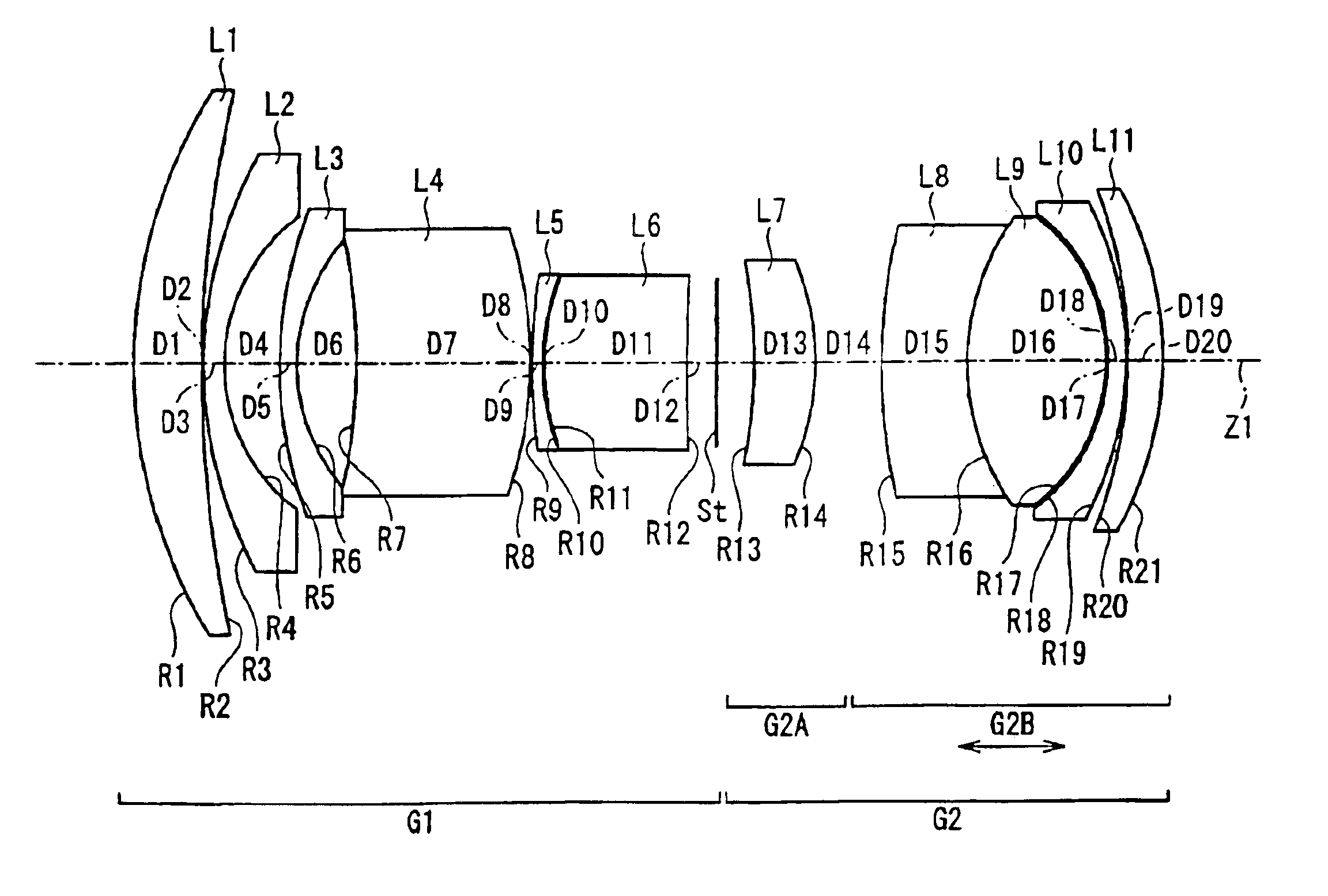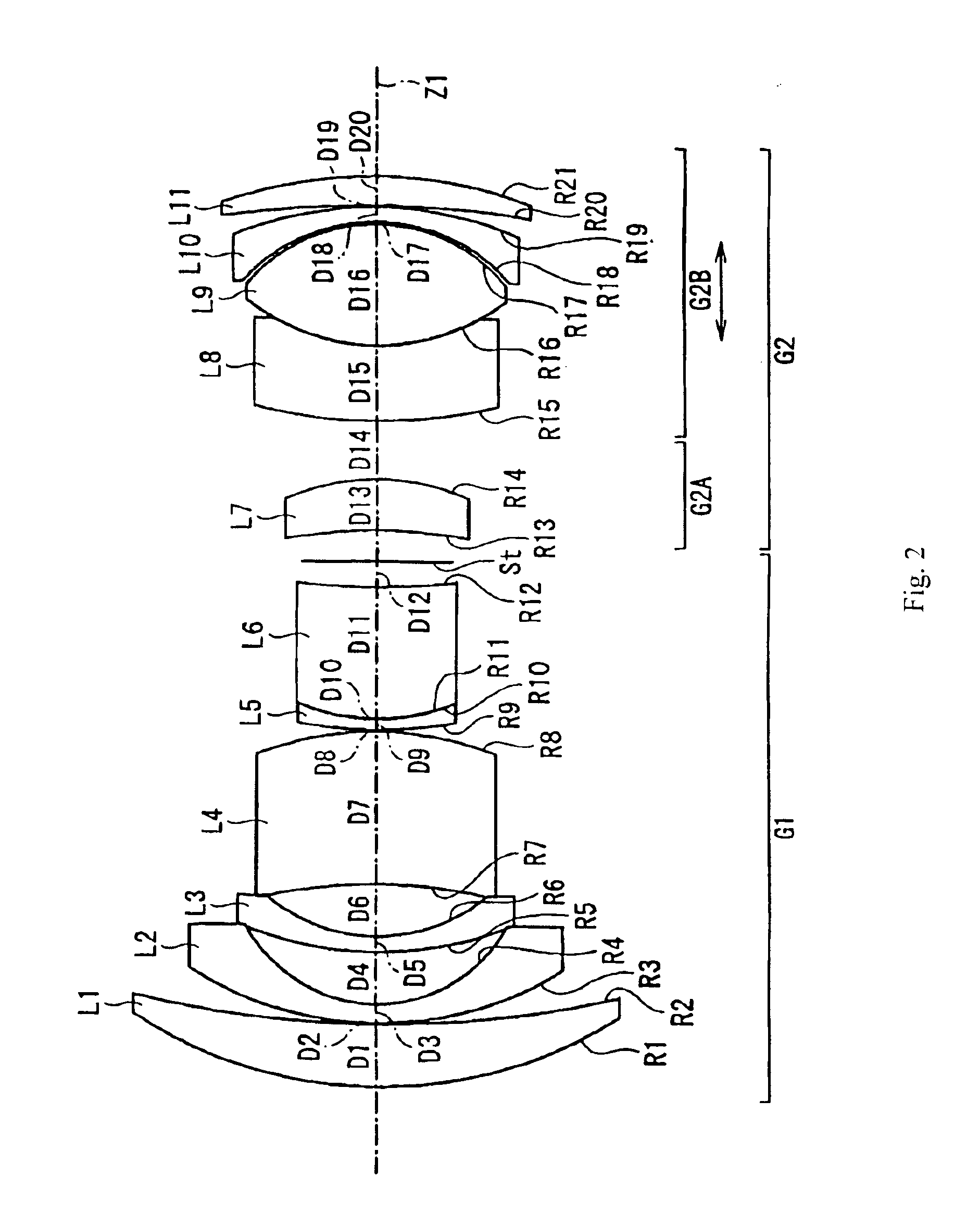Retrofocus, wide-angle lens
- Summary
- Abstract
- Description
- Claims
- Application Information
AI Technical Summary
Benefits of technology
Problems solved by technology
Method used
Image
Examples
embodiment 1
[0044]FIG. 1 shows the basic lens element configuration and lens group positions of the retrofocus, wide-angle lens of the present invention and specifically shows Embodiment 1.
[0045]Table 1 below lists the group identifier at the first object-side lens surface of the lens group, the surface number # in order from the object side, the radius of curvature R (in mm) of each surface, the on-axis surface spacing D (in mm), as well as the refractive index Nd and the Abbe number νd (both at the d-line) of each lens element for Embodiment 1. Listed in the middle portion of Table 1 are the focal length f, the f-number FNO, the maximum image angle 2ω, φ17, and the back focal length fB for Embodiment 1. Furthermore, listed in the bottom portion of Table 1 are the values corresponding to Conditions (1)-(10) for Embodiment 1.
[0046]
TABLE 1Group#RDNdνdG1160.7738.081.7433049.22145.3410.15350.6352.441.8466623.8421.3626.71550.5842.041.8340037.3622.2247.087−71.42920.951.4874970.48−50.0340.20966.9051....
embodiment 2
[0048]Embodiment 2, shown in FIG. 2, is very similar to Embodiment 1 and uses the same number of lens elements. Because Embodiment 2 is very similar to Embodiment 1, the differences between Embodiment 2 and Embodiment 1 will be evident from Table 2 that follows.
[0049]Table 2 below lists the group identifier at the first object-side lens surface of the lens group, the surface number # in order from the object side, the radius of curvature R (in mm) of each surface, the on-axis surface spacing D (in mm), as well as the refractive index Nd and the Abbe number νd (both at the d-line) of each lens element for Embodiment 2. Listed in the middle portion of Table 2 are the focal length f, the f-number FNO, the maximum image angle 2ω, φ17, and the back focal length fB for Embodiment 2. Furthermore, listed in the bottom portion of Table 2 are the values corresponding to Conditions (1)-(10) for Embodiment 2.
[0050]
TABLE 2Group#RDNdνdG1160.4848.051.7433049.22141.9740.14347.2662.421.8466623.8419....
embodiment 3
[0052]Embodiment 3, shown in FIG. 3, is very similar to Embodiment 1 and uses the same number of lens elements. Because Embodiment 3 is very similar to Embodiment 1, the differences between Embodiment 3 and Embodiment 1 will be evident from Table 3 that follows.
[0053]Table 3 below lists the group identifier at the first object-side lens surface of the lens group, the surface number # in order from the object side, the radius of curvature R (in mm) of each surface, the on-axis surface spacing D (in mm), as well as the refractive index Nd and the Abbe number νd (both at the d-line) of each lens element for Embodiment 3. Listed in the middle portion of Table 3 are the focal length f, the f-number FNO, the maximum image angle 2ω, φ17, and the back focal length fB for Embodiment 3. Furthermore, listed in the bottom portion of Table 3 are the values corresponding to Conditions (1)-(10) for Embodiment 3.
[0054]
TABLE 3Group#RDNdνdG1162.0058.851.7433049.22148.9370.15353.6382.661.8466623.8422....
PUM
 Login to View More
Login to View More Abstract
Description
Claims
Application Information
 Login to View More
Login to View More - R&D
- Intellectual Property
- Life Sciences
- Materials
- Tech Scout
- Unparalleled Data Quality
- Higher Quality Content
- 60% Fewer Hallucinations
Browse by: Latest US Patents, China's latest patents, Technical Efficacy Thesaurus, Application Domain, Technology Topic, Popular Technical Reports.
© 2025 PatSnap. All rights reserved.Legal|Privacy policy|Modern Slavery Act Transparency Statement|Sitemap|About US| Contact US: help@patsnap.com



